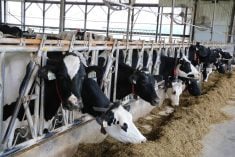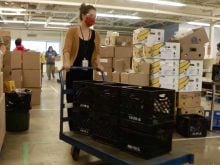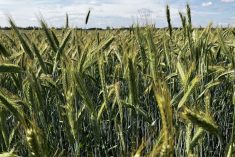While it’s too early to get a really clear picture of the effect that this spring’s delayed seeding will have on the 2022 crop, Manitoba’s crop experts have teased out a few signals of things to come.
Why it matters: Manitoba’s seeding has been weeks behind schedule, thanks to string after string of rain and snowstorms since late April.
Some of those revelations are more positive than might be expected, in a year where seeding was only four per cent done by the second week of May.
Manitoba Agriculture oilseed specialist Dane Froese appears to have found the silver lining in the never-ending bank of rain clouds hovering over Manitoba in the past two months.
“Given the fact that we do have adequate moisture now to grow a crop and we’re not in the drought situation we were last year, (that) means there is positive yield potential out there,” he said.
Of course, yield curves decline over time, and the yield potential won’t be as high as it might have been if seeding had begun in early May, but some crops could still remain unaffected by the deluge. Corn, for example, he noted, has a much steeper yield drop-off than canola, which “can have almost full yield potential right up until the first or second week of June,” Froese said.
However, when you only have one hand to play, you have to rely on the gamblers’ math that says the streak of bad luck has to end at some point.
“We have to work with the environment that we get, and generally in years when we have late or delayed springs, we typically have an open fall as well. So that’s what we’re counting on to make sure some of these crops get to maturity,” Froese said.
Soybeans
Daryl Domitruk, executive director of the Manitoba Pulse and Soybean Growers, expects to see a drop in acres for soybeans this year.
“I think it’s reasonable to expect we will see overall lower acres. That’s because we will lose acres in the truly flooded areas,” he said.
While there are areas with lighter ground that have been seeded more or less on time, closer to the Red River, where a significant number of soybeans are grown, Domitruk expects less crop to go in the ground. He also expects some losses in the areas with shorter growing seasons and, consequently, an earlier seeding deadline with the Manitoba Agricultural Services Corporation (MASC).
But Domitruk also sees a silver lining in this bad-weather year.
“These kinds of years always underline the importance of diversity and having options,” he said.
Outlier years also allow researchers to probe the statistical fringes of crops and growing regions, something that is immensely helpful for those studying a crop like soybeans, still a relative newcomer to Manitoba when compared to stalwarts like wheat and canola. During the crop’s relatively short tenure in Manitoba, there has been a significant increase in the soybean knowledge base, along with new, earlier-maturing varieties coming out every year.
“We’re always working with MASC to update their knowledge, and they’re always looking at their own data to update their knowledge about this crop,” Domitruk said. “We’re in the midst of understanding and building that crop. That really comes to the surface in years like this.”
Disease
Plant disease experts are also eyeing Manitoba’s moisture for its role in what pathogens might become an issue this year.
“The root pathogens that do well, or hurt the crop the most when it’s wet, are pythium and phytophthora,” Manitoba Agriculture’s field crop pathologist, David Kaminski said. “Pythium feeds on the fine feeder roots and prunes them off. It’s very difficult to see, but it can hold back the crop from starting.”
While pythium is a concern for cereals, phytophthora will be the larger threat for broadleaf crops.
“Once it gets going on the major root, it can work its way up the stem to cause problems later on,” Kaminski said.
Farm stress
But the effects of bad-weather years like this — especially when the bad luck spans two growing seasons, looking back to the 2021 drought — can affect more than just seeded acres and yield potential. There is also a human cost.
“How we cope with all of those things is a real challenge,” Keystone Agricultural Producers president, Bill Campbell said. “I hope that we have producers reaching out for mental health assistance if it’s needed and that neighbours are looking out for one another.”
Campbell also stressed the role of organizations like the Do More Ag Foundation, which centres around promoting mental health in agriculture, and the Manitoba Farm, Rural, and Northern Support line play.
“To go from one extreme to the other within 12 months is quite daunting,” he said. “(The drought) was pretty widespread and significant last summer. And then we go to a time of excess moisture and flooding. Those scenarios challenge a producer’s ability to cope. Everyone has a breaking point and we just need to ensure that, that mental health and that community awareness are there.”
















